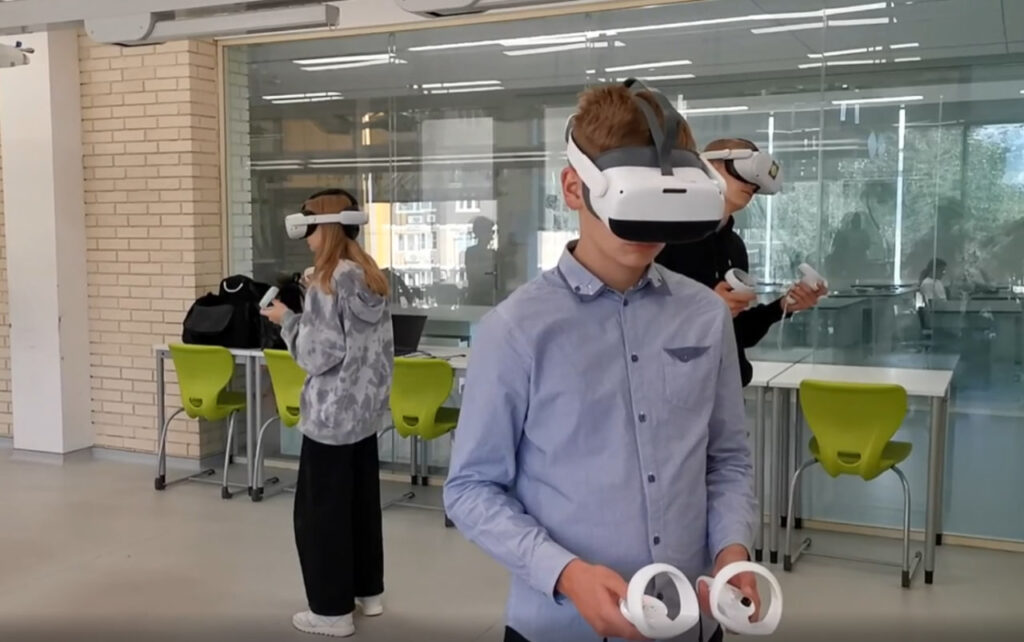

Did the title raise eyebrows? Let’s face it, these words capture a sentiment many educators feel: “We don’t need newfangled gadgets; we just want to teach like we always have.” But the world is evolving at breakneck speed, and VR in education is no exception. Even if you try to resist it, virtual reality in schools will inevitably become part of tomorrow’s classrooms.
Modern technology, from AI tools to immersive headsets, has already redefined multiple sectors. Look at AI—just a few years ago, it felt mysterious and out of reach for most. Now, anyone can use AI to write texts, craft presentations, analyze data, and even create videos. Those who still ignore or resist AI’s benefits risk being left behind. VR (or V/R) is on a similar trajectory. It can seem intimidating, conjuring images of people losing themselves in a digital realm. But like any powerful tool—be it AI or VR—the key lies in harnessing it responsibly and learning to benefit rather than suffer from its possible downsides.
Many teachers are wary of VR learning. They’ve seen new fads come and go, or they simply don’t have time to explore untested methods. After all, they’re already juggling lesson plans, grading, and the everyday demands of a digital classroom. The idea of adding “VR class setups” can feel overwhelming.

Yet ironically, these educators are the same people who quickly adopted AI to handle routine tasks. Tools like the ones in our article on Top 5 AI Tools for Teachers show how easily technology can lighten workloads. The story with VR is similar: once teachers realize its potential to simplify certain aspects of teaching and inspire students, the resistance often melts away.
Technology isn’t always sunshine and rainbows. With the rise of AI, we’ve also seen an uptick in scams and spam. Similarly, VR can be used unproductively, leading to excessive screen time or even detachment from reality. However, this doesn’t mean schools should run in the opposite direction. Instead, it’s a call for teachers, parents, and authorities to establish clear boundaries and guidelines.

Despite the initial anxiety, benefits of virtual reality in education far outweigh potential pitfalls:
Yes, VR can feel like a massive leap. Yet only a few years back, AI was that “scary unknown.” Now, ignoring AI means you’re missing out on countless opportunities. VR follows the same path: if schools remain stuck in old methods, they’ll rob students of crucial experiential learning. The world is changing, and our technology in education must keep up.
Children can’t be expected to set rules for themselves. They might not distinguish between beneficial VR sessions—like exploring the inside of a cell or analyzing wave interference—and purely entertaining or even harmful uses of the technology. That’s where adults come in, shaping virtual reality education to maximize learning and minimize risks.

Curious about how VR can fit into your lesson plans? XReady Lab specializes in curriculum-aligned VR learning solutions that integrate seamlessly with official syllabi. Experience the benefits of VR education firsthand, see how it complements your teaching style, and discover why resisting VR is a losing battle.
Request Your Free Demo Today and see how VR can revolutionize your STEM lab meaning, support a VR physics experiment, or bring VR biology lessons to life without adding more stress to your day.
Like it or not, VR is coming. You can fight it, but the momentum is clear. Think of how quickly AI moved from “scary and inaccessible” to “essential and ubiquitous.” The same pattern emerges with VR in education. Yes, there are dangers—just as with any powerful technology—but the rewards are immense.
Modern kids are growing up in a world shaped by instant communication, interactive experiences, and boundless information. VR simply aligns with that reality. So, go ahead and resist all you want, but sooner or later, you’ll find yourself embracing virtual reality and education. And when you do, your students will thank you for taking the leap.
Resist VR in education if you must—but remember, the future won’t wait.
Frequently Asked
We prodive VR biology, VR physics, and VR chemistry simulations. Please, check our catalog.
Please, fill the form to get demo labs for free.
Please contact our customer support service at support@xreadylab.com or book a call with the team to find out the conditions and book the VR class set up at your school.
Subscription to XReady Lab interactive VR labs. If you are a school, then you are also given access to the VR classroom system. VR class system helps you easily launch VR lessons for a large number of students, follow the experience of each student, as well as customise the content without developers.
We adhere to the world’s generally accepted recommendations and research. Our products are suitable for children from 12 years old.